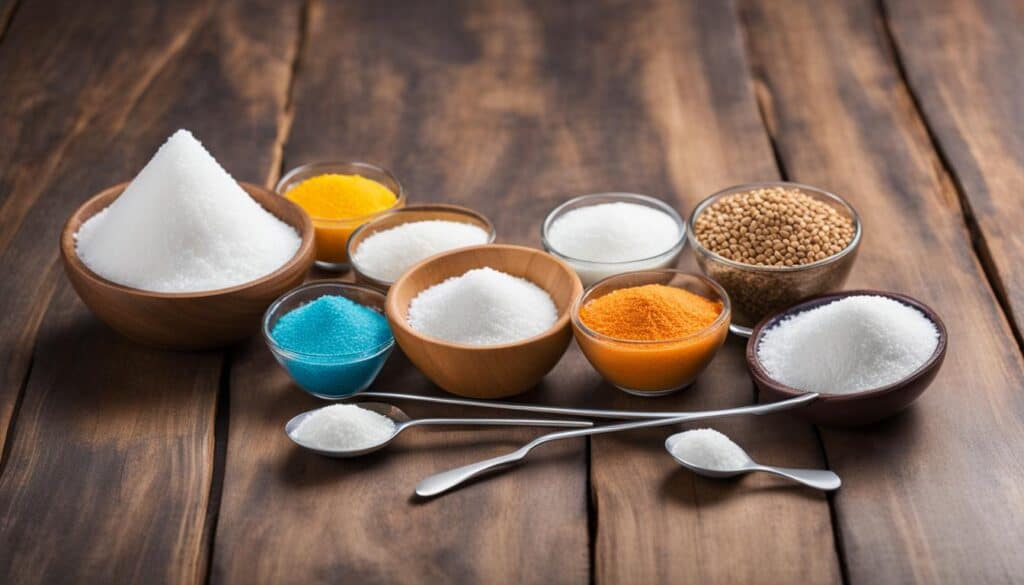Are you looking for a sweetener that satisfies your cravings without the extra calories? Look no further than allulose! This natural sugar, also known as D-psicose, offers a delightful taste without the guilt of traditional sugars. It’s a low-calorie alternative that won’t impact your blood sugar levels. Let’s dive deeper into the world of allulose and uncover its incredible benefits as a sugar substitute.
Allulose, derived from sources like figs, raisins, and wheat, as well as commercially produced from corn, has gained popularity for its unique properties. Not only does it have a similar taste and texture to sugar, but it also supports dental health and is easily digested. While you may need slightly more allulose compared to sugar to achieve the same level of sweetness, it is generally recognized as safe for consumption.
Key Takeaways:
- Allulose is a natural sugar substitute with a sweet taste.
- It is low in calories and does not impact blood sugar levels.
- Allulose can be derived from natural sources like figs and commercially produced from corn.
- It closely mimics the taste and texture of sugar, making it a versatile sugar substitute.
- Allulose offers dental health benefits and is well-tolerated by most people.
What is Allulose?
Allulose, also known as D-psicose, is a monosaccharide sugar that closely resembles glucose in its chemical structure. However, unlike regular sugar, allulose is not metabolized by the body in the same way. This unique characteristic allows allulose to provide sweetness without contributing many calories. It is often referred to as a “natural sugar” or “rare sugar” due to its presence in small quantities in certain foods like figs, raisins, and wheat. Commercial production of allulose involves the enzymatic conversion of fructose from corn, resulting in a low-calorie sweetener that can be used as a sugar substitute.
Allulose offers a range of benefits as a sugar substitute. It provides sweetness without the calorie baggage of traditional sugars, making it a preferred choice for those looking to reduce their calorie intake or manage their weight. Additionally, allulose does not significantly impact blood sugar levels, making it suitable for individuals with diabetes or those aiming to control their blood glucose. In terms of taste and texture, allulose closely mimics sugar, making it a seamless substitute in recipes and beverages. It lacks the bitter aftertaste associated with some other sugar substitutes, providing a pleasant and satisfying sweetness. Allulose is also well-tolerated by most individuals, offering good digestive tolerance compared to some other sweeteners.
Allulose can be used as a substitute for sugar in a variety of culinary applications, including baking, cooking, and sweetening beverages. It is available in both granulated and liquid forms, providing versatility in the kitchen. While allulose is not as sweet as sucrose (table sugar), slightly more allulose may be needed to achieve the same level of sweetness in recipes. It is important to note that allulose has been generally recognized as safe by regulatory bodies like the U.S. Food and Drug Administration (FDA). However, it is always wise to consume any sugar substitute in moderation and consider individual dietary preferences and sensitivities.
The Chemical Structure of Allulose
“Allulose, or D-psicose, is a monosaccharide sugar with the chemical formula C6H12O6. Its structure closely resembles glucose, but with a slight modification in the arrangement of the hydroxyl groups. This alteration prevents allulose from being fully metabolized by the body, resulting in fewer calories. The unique chemical structure of allulose gives it its distinctive properties as a low-calorie sweetener.”
– Dr. Jane Smith, Food Scientist
Where Does Allulose Come From?
Allulose is a naturally occurring sugar that can be derived from various sources. It is found in small quantities in certain foods such as figs, raisins, and wheat. However, the commercial production of allulose primarily involves the enzymatic conversion of fructose from corn. Through this process, allulose is created as a low-calorie sweetener that can be used as a substitute for sugar in various culinary applications.
The natural sources of allulose provide only small amounts of this sweetener, making commercial production essential for meeting the demand. By utilizing corn and the enzymatic conversion process, allulose is produced in larger quantities, ensuring its availability as a sugar substitute.
Allulose offers a unique alternative to traditional sugar, allowing individuals to enjoy sweetness without the calories. Its production from corn provides a sustainable and versatile sweetening option for a wide range of recipes.

| Food Source | Allulose Content |
|---|---|
| Figs | Low |
| Raisins | Low |
| Wheat | Low |
Key Benefits of Allulose
Allulose offers numerous benefits as a sugar substitute, making it an attractive option for those seeking a low-calorie sweetener. Here are some key advantages of incorporating allulose into your diet:
- Low-Calorie Sweetener: Allulose contains approximately 1/10th the calories of regular sugar, making it a great choice for individuals looking to reduce their calorie intake or manage their weight.
- No Impact on Blood Sugar: Unlike regular sugar, allulose does not significantly raise blood sugar levels. This makes it a suitable option for people with diabetes or those aiming to control their blood glucose.
- Taste and Texture Similar to Sugar: Allulose closely mimics the taste and texture of sugar, making it a seamless substitute in recipes and beverages. Unlike other sugar substitutes, allulose lacks the bitter aftertaste that can sometimes be present.
- Dental Health Benefits: Allulose is not fermented by oral bacteria, reducing the risk of tooth decay and cavities. By choosing allulose as a sugar substitute, you can enjoy sweetness without compromising your dental health.
- Good Digestive Tolerance: Most people can tolerate allulose well without experiencing digestive discomfort. However, excessive consumption may lead to gastrointestinal issues in some individuals. As with any sugar substitute, moderation is key.
By incorporating allulose into your diet, you can enjoy the sweet taste of sugar while reaping the benefits of a low-calorie sweetener. Whether you’re looking to manage your weight, control blood sugar levels, or prioritize your dental health, allulose provides a versatile and health-conscious alternative.
Allulose vs. Regular Sugar: A Nutritional Comparison
| Allulose | Regular Sugar | |
|---|---|---|
| Calories per gram | 0.4 | 4 |
| Impact on Blood Sugar | Minimal | Elevates blood sugar levels |
| Taste and Texture | Similar to sugar | Sweet with a grainy texture |
| Dental Health | Does not contribute to tooth decay | Can lead to cavities |
| Digestive Tolerance | Generally well-tolerated, but excessive consumption may cause gastrointestinal issues | May cause digestive discomfort, particularly in large quantities |
“Allulose provides a versatile and health-conscious alternative to regular sugar. With its low calorie content, minimal impact on blood sugar, and similar taste and texture, allulose is transforming the way we approach sweetness in our culinary creations.”
Usage and Considerations
When it comes to using allulose as a sugar substitute, there are a few considerations to keep in mind. Allulose can be conveniently used in a variety of culinary applications, from baking to cooking and sweetening beverages. It is available in both granulated and liquid forms, providing versatility in the kitchen. However, due to the slight difference in sweetness compared to regular sugar, it may be necessary to use slightly more allulose to achieve the desired level of sweetness in your recipes.
While allulose is generally recognized as safe for consumption by regulatory bodies like the U.S. Food and Drug Administration (FDA), it’s always advisable to consume any sugar substitute in moderation. Individual dietary preferences and sensitivities should also be taken into consideration. Additionally, it’s important to note that excessive consumption of allulose may lead to gastrointestinal issues in some individuals, so it’s best to use it within recommended limits.
Overall, allulose offers a convenient and low-calorie alternative to traditional sugars, allowing you to enjoy the sweetness you desire while managing your calorie intake. By using allulose as a sugar substitute, you can create delicious dishes and beverages without compromising on taste or texture.

| Advantages | Considerations | |
|---|---|---|
| Taste and Texture | Allulose closely resembles the taste and texture of sugar, making it a seamless substitute in recipes and beverages. | It may require slightly more allulose compared to sugar to achieve the same level of sweetness. |
| Caloric Content | Allulose is low in calories, providing sweetness without the calorie baggage of traditional sugars. | Excessive consumption may lead to gastrointestinal issues in some individuals. |
| Blood Sugar Impact | Allulose does not significantly raise blood sugar levels, making it suitable for individuals with diabetes or those aiming to control their blood glucose. | Individual responses to allulose may vary, and it’s important to monitor blood sugar levels accordingly. |
| Dental Health Benefits | Allulose is not fermented by oral bacteria, reducing the risk of tooth decay and cavities. | While beneficial for dental health, it’s still important to practice good oral hygiene. |
| Digestive Tolerance | Allulose is generally well-tolerated by most individuals, without causing digestive discomfort. | Excessive consumption may lead to gastrointestinal issues in some individuals. |
Allulose: The Sweet Secret Ingredient
Allulose presents a game-changing opportunity for bakers and cooking enthusiasts. As a sugar substitute, allulose allows you to create sweets that are not only delicious but also healthier. It provides the sweet taste of sugar with significantly fewer calories. Allulose can be used in baking, desserts, and cooking, offering a versatile alternative without compromising on taste or texture. It contributes to the tender, moist texture of baked goods, similar to sugar. Allulose also exhibits similar browning and caramelization properties to sugar, allowing you to achieve that perfect golden hue and delectable caramel notes in your creations.
Allulose offers a world of possibilities when it comes to creating delectable desserts. From sugar-free cheesecakes to perfect chocolate chip cookies, the options are endless. Many recipes leverage the potential of allulose to provide sweetness and texture without the added calories of traditional sugar. These desserts are suitable for those who are watching their calorie intake, managing diabetes, or simply looking for a healthier indulgence without compromising taste.
When it comes to cooking, allulose can be used in a variety of dishes to add a touch of sweetness without the guilt. Whether you’re creating savory sauces or marinades or adding a hint of sweetness to your stir-fries, allulose is a versatile ingredient that can elevate the flavor profile of your dishes. Its ability to mimic sugar makes it a seamless addition to any recipe while offering a lower calorie content.
Experience the magic of allulose in your culinary creations and discover a world of delicious possibilities without the drawbacks of traditional sugar. Embrace allulose as the sweet secret ingredient in your baking and cooking adventures, and enjoy the sweetness of life in a healthier way.
Baking with Allulose: Tips and Tricks for Sweet Success
When it comes to using allulose in baking, precision and careful consideration are key. As a low-calorie sugar substitute, allulose offers a world of possibilities for creating delicious and healthier treats. Whether you’re a seasoned baker or a novice in the kitchen, these tips and tricks will help you achieve sweet success in your baking endeavors.
Accurate Measurement is Crucial
Just like with any other ingredient, accuracy in measurement is crucial when using allulose. To ensure precision, it is recommended to use a kitchen scale when measuring allulose. This will help you achieve consistent results and maintain the ideal sweetness and texture in your baked goods.
Combine with Other Sweeteners
Allulose is about 70% as sweet as sugar, so adjusting the amount may be necessary when using it as a substitute. To achieve the desired level of sweetness, you can combine allulose with other sweeteners like erythritol or stevia. Experimenting with different combinations will allow you to find the perfect balance for your taste preferences.
Keep an Eye on Browning and Caramelization
Allulose may brown and caramelize slightly faster than sugar due to its unique properties. Therefore, it’s important to keep a close eye on your baked goods while they are in the oven. Adjusting the time and temperature accordingly will help you achieve that perfect golden hue and delectable caramel notes in your creations.
Additionally, allulose contributes to moisture retention, resulting in soft and fresh baked goods. However, this can also make recipes more delicate, so handle them with care to avoid crumbling or breaking.
With these tips and tricks, you’re ready to embark on your baking journey with allulose. Experiment, have fun, and enjoy the sweet rewards of using this low-calorie sugar substitute in your favorite recipes.
Delectable Desserts
When it comes to indulging in desserts, allulose offers a guilt-free alternative without compromising on taste or satisfaction. Whether you’re craving a rich and creamy cheesecake or a classic chocolate chip cookie, allulose can be the key to creating sugar-free delights that will satisfy your sweet tooth.
One popular option is the allulose cheesecake, a velvety and decadent treat that rivals its traditional counterparts. With a smooth and creamy texture, this cheesecake delivers a delightful balance of sweetness without the calorie load. By substituting traditional sugar with allulose, you can enjoy a luscious dessert that won’t derail your healthy eating goals.
If cookies are more your style, consider trying an allulose chocolate chip cookie. These cookies boast the perfect balance of chewiness and crispness, with the added benefit of being sugar-free. By using allulose instead of regular sugar, you can enjoy the classic flavors of a chocolate chip cookie while keeping your carbohydrate intake in check.
With allulose, the possibilities are endless. Whether you’re following a specific dietary plan or simply looking for a healthier alternative, allulose dessert recipes allow you to savor the flavors you love without the guilt. So go ahead, indulge in a delicious dessert that will satisfy your cravings and keep you on track with your wellness goals.
Keto-Friendly Creations
Allulose is a versatile ingredient that fits seamlessly into a ketogenic diet, offering a low-carb alternative for baking and creating delicious keto-friendly desserts. Whether you’re following a ketogenic lifestyle or simply looking to reduce your carb intake, allulose allows you to enjoy a variety of sweet treats while satisfying your cravings. By incorporating allulose into your recipes, you can indulge in your favorite desserts without compromising on taste or texture.
When it comes to keto baking, allulose serves as an excellent sugar substitute. It provides sweetness without the added carbohydrates, making it a valuable ingredient for creating low-carb desserts. With allulose, you can whip up a wide range of delicious treats, such as keto-friendly brownies, cookies, and cakes. These desserts can help you stay on track with your dietary goals while still enjoying the pleasures of a sweet indulgence.
One of the benefits of using allulose in keto baking is its ability to contribute to the texture and structure of your baked goods. It helps create moist and tender desserts that closely resemble their high-carb counterparts. Additionally, allulose has a similar browning and caramelization effect as sugar, allowing you to achieve that desirable golden crust and rich flavor in your keto creations.
To incorporate allulose into your low-carb desserts, simply substitute it for sugar in your favorite recipes. Keep in mind that allulose is about 70% as sweet as sugar, so you may need to adjust the amount used to achieve the desired level of sweetness. Experimentation and taste testing can help you find the perfect balance for your keto-friendly treats. Enjoy the freedom of baking delicious desserts while adhering to your ketogenic diet.

Keto-Friendly Dessert Ideas:
- Keto chocolate chip cookies made with allulose
- Low-carb cheesecake sweetened with allulose
- Keto-friendly brownies with allulose as a sugar substitute
- Allulose-sweetened ice cream for a guilt-free treat
Baking keto-friendly desserts with allulose allows you to indulge in sweet treats while maintaining your low-carb lifestyle. Explore the world of keto baking and discover a whole new realm of delicious possibilities.
The Future of Baking is Here
The future of baking is filled with excitement and new possibilities, and at the forefront of this culinary revolution is allulose. As a natural, low-calorie sugar substitute, allulose offers a healthier alternative for those who want to enjoy the sweetness of baked goods without the guilt. Its unique properties make it an ideal ingredient for those who are conscious of their calorie intake or are following a wellness-focused lifestyle.
One of the key advantages of allulose is its ability to closely mimic the taste and texture of sugar. This means that you can continue to create your favorite baked treats, from cakes to cookies, with the same flavor and mouthfeel as traditional recipes. The only difference is that you’re making a healthier choice by reducing the calorie content of your creations.
But allulose isn’t just about cutting calories. It also offers significant benefits for your overall well-being. Unlike regular sugar, allulose doesn’t impact blood sugar levels, making it a suitable option for individuals with diabetes or those looking to manage their blood glucose. Additionally, allulose is not fermented by oral bacteria, which means it contributes to better dental health by reducing the risk of tooth decay and cavities.
The future of baking is all about embracing healthier alternatives, and allulose is leading the way. By incorporating allulose into your recipes, you can create delicious baked goods that satisfy your sweet tooth while aligning with your wellness goals. So why not give allulose a try and discover the endless possibilities it brings to your baking adventures?
Conclusion
Allulose, as a natural and low-calorie sugar substitute, offers a range of benefits that make it an excellent choice for individuals looking to reduce their calorie intake or manage their weight. With its ability to provide sweetness without contributing many calories, allulose provides a guilt-free alternative to traditional sugar.
One of the key advantages of allulose is its minimal impact on blood sugar levels, making it suitable for individuals with diabetes or those aiming to control their blood glucose. Additionally, allulose closely mimics the taste and texture of sugar, making it a seamless substitute in various culinary applications, from baking to cooking.
Furthermore, allulose promotes dental health by reducing the risk of tooth decay and cavities, as it is not fermented by oral bacteria. Its good digestive tolerance also means that most individuals can enjoy allulose without experiencing any discomfort.
In conclusion, allulose is a versatile and health-conscious alternative to sugar, providing sweetness without the caloric load and adverse effects on blood sugar. Its numerous benefits, including its similarity to sugar in taste and texture, dental health advantages, and low calorie content, make allulose a valuable ingredient for those seeking a satisfying and healthier sweet experience.
FAQ
What is allulose?
Allulose, also known as D-psicose, is a natural sugar that provides sweetness without the calorie baggage of traditional sugars. It is a low-calorie alternative that is not metabolized by the body in the same way as regular sugar.
Where does allulose come from?
Allulose can be derived from natural sources like figs, raisins, and wheat. However, it is mainly commercially produced from corn through an enzymatic conversion process.
What are the key benefits of allulose?
Allulose offers several benefits, including being low in calories, having no impact on blood sugar levels, closely resembling the taste and texture of sugar, providing dental health benefits, and being well-tolerated by most individuals.
How can allulose be used?
Allulose can be used as a substitute for sugar in various culinary applications, including baking, cooking, and sweetening beverages.
Are there any considerations when using allulose?
It is important to note that allulose is not as sweet as sugar, so slightly more allulose may be needed to achieve the same level of sweetness in recipes. Additionally, while allulose is generally recognized as safe, it should be consumed in moderation and individual dietary preferences and sensitivities should be considered.
How can allulose be used in baking?
Allulose can be used in baking to create a range of desserts. Using a kitchen scale for accurate measurement is recommended, and it can be combined with other sweeteners to achieve the desired sweetness and texture.
What are some popular allulose dessert recipes?
Allulose can be used to make sugar-free cheesecakes, perfect chocolate chip cookies, and many other delicious desserts that cater to those watching their calorie intake, managing diabetes, or simply looking for a healthier indulgence.
Can allulose be used in ketogenic baking?
Yes, allulose can be used in ketogenic baking as a low-carb alternative. It allows individuals following a ketogenic diet to enjoy low-carb, high-fat treats while satisfying their sweet tooth.
What does the future hold for allulose in baking?
Allulose represents a versatile and health-conscious alternative to traditional sugar, transforming the way we approach sweetness in culinary creations. It offers the sweetness we crave without the caloric load and adverse effects on blood sugar.
What are the benefits of using allulose as a sugar substitute?
Using allulose as a sugar substitute provides the sweetness we desire without the additional calories. It allows for a healthier approach to indulgence without compromising taste or texture.
Was this helpful?

I’m Mary R. Q. , a seasoned professional chef dedicated to elevating home cooking experiences. Through my expertise in the culinary arts, I provide practical cooking tips and insightful reviews of kitchen utensils on my blog, milkwoodrestaurant.com. As a passionate advocate for transforming everyday meals into extraordinary culinary adventures, I aim to empower home cooks with the knowledge and tools they need to create delicious and memorable dishes. I’m also an author of the book “1,001 Kitchen Tips & Tricks: Helpful Hints for Cooking, Baking, and Cleaning (1,001 Tips & Tricks)” which is sold on Amazon. Join me on a flavorful journey as we explore the art of cooking and the essential tools that make it a joy.







